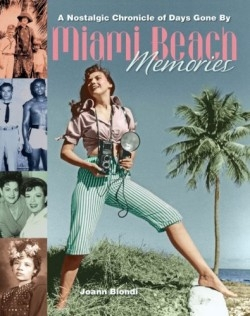Miami Beach Memories
A Nostalgic Chronicle of Days Gone
Long before South Beach became a famous international tourist destination, Miami Beach was a renowned entertainment center, filled with celebrities, gaudy hotels, gamblers, restrictions, prejudice, and racism. Decade by decade, from the 1920s through the 1960s, the story of Miami Beach’s rise and fall is told in this book through the eyes of its residents and visitors. The author interviewed more than a hundred people, and her book is replete with well-chosen excerpts from those interviews. Her informants are listed in a “cast of characters” with biographical information about each one.
Miami Beach is “a tiny spit of sand barely fifteen miles long and a mile wide.” Two “visionaries,” John Collins and Carl Fisher, cleaned up the barrier island to turn it into a “self-contained playground for the rich.” As the population grew from 600 to 15,000 in the 1920s, Miami Beach “was a WASP-controlled island where Old Money ruled” and anti-Semitism prevailed. Jews were barred from hotels and restricted to a tiny ghetto, now known as South Beach. Destruction caused by the hurricane of 1926 wreaked havoc on the real estate boom. During the Depression of the 1930s, developers built pastel-colored hotels that became known as the Art Deco architectural style. Jews, Irish Catholics, and Blacks experienced severe discrimination, although many of the investors were Jewish. Perhaps the best-known resident those days was notorious gangster Al Capone. Visitors included Amelia Earhart, Damon Runyon, Calvin Coolidge, Al Jolson, Charles Lindbergh, and the Duke and Duchess of Windsor.
During the 1940s, Miami Beach became a military training center, with hotels transformed into barracks and hospitals for more than 400,000 soldiers. After the war, many of them returned as tourists or residents. The Jewish community increased to more than 35,000, becoming a potent political and cultural force. Backroom gambling, strippers, musicians, and comedians delighted the hordes of visitors, including famous luminaries. In the 1950s, celebrities flocked to Miami Beach, with Frank Sinatra and his “Rat Pack” leading the parade. Jews came into their own with elaborate bar mitzvahs, sweet sixteen parties, Jewish restaurants, and Borscht Belt entertainers. Mobster Meyer Lansky lived quietly in a condo on Collins Avenue.
The 1960s saw the Beatles in Miami Beach for their second American appearance; Muhammad Ali won the heavyweight championship at the Miami Beach Auditorium; the Jackie Gleason show aired from Miami Beach. The Golden Era ended as other destinations became popular, and not until the revival of South Beach in the 1990s, did it flourish again.
The exciting story of Miami Beach’s ups and downs is well told with great verve in this excellent assortment of exhilarating recollections. A resident of Miami, Biondi has written books and articles on travel and celebrities. Her interest in interviewing has led her to establish a memoir-writing service to help people prepare oral histories as the basis for getting autobiographies into print.
Reviewed by
Morton I. Teicher
Disclosure: This article is not an endorsement, but a review. The publisher of this book provided free copies of the book to have their book reviewed by a professional reviewer. No fee was paid by the publisher for this review. Foreword Reviews only recommends books that we love. Foreword Magazine, Inc. is disclosing this in accordance with the Federal Trade Commission’s 16 CFR, Part 255.

